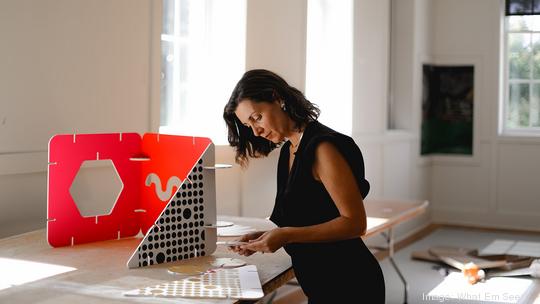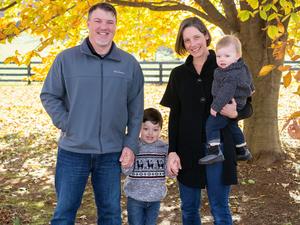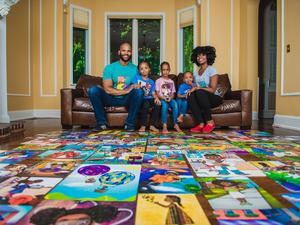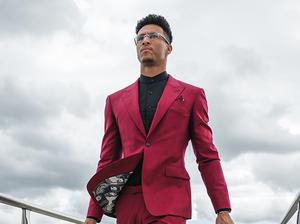
Chloe Varelidi, an architect by training, mother of two and D.C. resident, is the founder of Follies, a brand of toys that features big building shapes kids can connect to create whatever they imagine. Follies was part of Georgetown’s Halcyon incubator.
Why did you create Follies? A few years ago, I was visiting the National Gallery here in D.C. with my then 2-year-old daughter. It was one of those rainy weekends and we were killing time walking around the rooms. When we reached the room with Alexander Calder’s mobiles, my daughter said “Toys!” I thought to myself, “Yes, why couldn’t toys be more like art?” Even though I had been working for 10 years in the space of children’s media, it was only when I had my own children that I became aware of how badly designed the majority of toys are, especially for young children. It was also important to me that we create a toy that is easy to stow away and look good when on display.
What were your artistic inspirations for the shapes that form Follies? I have always admired the work of the Eameses. The couple is known for their furniture and architectural designs of course, but they also had a deep admiration for creating play things such as the “Solar Do-Nothing Machine” from 1957. When I started exploring the idea of printing patterns on the Follies pieces for The Bauhaus Set, I looked to some of my inspirations from when I was in architecture school. I was interested in exploring the work of some of the women in the Bauhaus school like Anni Albers and her textile prints, [Ilse] Fehling’s sculptural objects and Alma Siedhoff-Buscher, one of the few women in the school to use the male-dominated wood workshop.
How can Follies have a social impact beyond your traditional playroom? In 2018, I had the honor of running a play workshop with children in refugee camps in Greece, where I am from originally. One of the first things I noticed was that the camp was packed with really young kids, and there was no space for them to play. Turns out that playgrounds cost thousands of dollars to build and maintain. What’s more, a child might stay in a refugee camp their entire childhood — imagine growing up without any access to a safe space to play? That is why we developed an open-source version of Follies, one that anyone in the world can download and use to create their own custom pop-up play space.
What are the most creative designs you’ve seen created with your product? It’s my favorite part of the day checking our Instagram and seeing what children’s imaginations have come up with that day. The most creative design I saw this week was a family of custom critters that use the smaller pieces from both the Bauhaus and Canvas set. The wiggle piece makes a great antenna.
Do computers and video games play too large a role in our kids’ playtime? I actually spent the majority of my career in kids media studying and developing digital games and tools. So I certainly am on the camp that believes there are many valuable skills children develop when playing video games or watching TV, especially when they have those experiences together with their parents when they are young or their peers when they are older. That said, children do need tactile stimulation especially when they are young and it’s immensely beneficial to them to use their bodies when playing. As with everything, it’s good to have a balance.
What was your favorite toy to play with as a kid? I was raised in Athens, Greece, and growing up, I would spend every day after school at my grandmother’s house. There were practically zero toys in that house but the neighborhood was packed with kids who would gather every afternoon to play on the street. So as a kid, I spent a lot of time inventing all sorts of toys and games outside with my friends. I remember we would often use my grandmother’s collection of upcycled yogurt cups — she was ahead of her time when it comes to sustainable living — to create entire miniature city systems outdoors.
Have an idea or pitch that reflects some unusual business activity? Email mneibauer@bizjournals.com.




